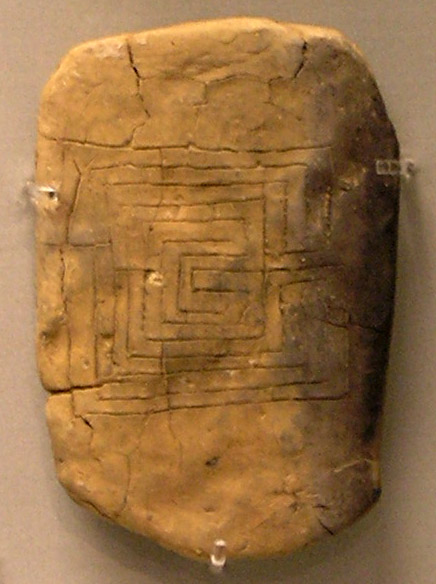|
Dali (goddess)
Dali (also Daal or Dæl; ) is a goddess from the mythology of the Georgian people of the Caucasus region. She is a hunting goddess who serves as the patron of hoofed wild mountain animals such as ibexes and deer. Hunters who obeyed her numerous taboos would be assured of success in the hunt; conversely, she would harshly punish any who violated them. She is most prominently attested in the stories of the Svan ethnic subgroup in northwestern Georgia. Other groups in western Georgia had similar figures considered equivalent to Dali, such as the Mingrelian goddess Tkashi-Mapa (). She was usually described as a beautiful nude woman with golden hair and glowing skin, although she sometimes took on the form of her favored animals, usually with some marking to differentiate her from the herd. She was said to reside in a cavern high in the mountains, where she kept watch over the hoofed game animals who live on the cliffs. Dali was styled with a variety of regional epithets reflecting ... [...More Info...] [...Related Items...] OR: [Wikipedia] [Google] [Baidu] |
Al (folklore)
''Al'' (or ''Hal'') ( fa, آل; hy, italic=yes, Ալ or Ալք; mn, italic=yes, Гал; ('); xal, italic=yes, Һал; russian: italic=yes, Алы) is a class of demon in the folklore of the Caucasus, Iran, Central Asia, and Armenia. Als are demons of childbirth, interfering with human reproduction. The al is known by various other names, including ''alk'' in Armenian and Kurdish, ''ol'', ''hāl'' and ''xāl'' in Tajikistan and Afghanistan, ''almasti'' or ''albasti'' in Central Asian Turkic-speaking countries, and ''halmasti'' among the Dards.Asatrian, 150. Other languages * hy, Ալ or ( or ) * lez, Ал () * ka, ალი () * Tat: () * tly, Ала () * udi, Һал () * ku, Alk, script=Latn or * tk, Ал () * fa, آل () Traditions In Armenian tradition, the als steal the lung, liver and heart of women in childbirth, pregnant women, and women who have just given birth. They also destroy embryos in the womb, causing miscarriage, and can steal babies forty days af ... [...More Info...] [...Related Items...] OR: [Wikipedia] [Google] [Baidu] |
Kevin Tuite
Kevin Tuite ( Irish: ''Caoimhín de Tiúit''; born April 3, 1954) is a full Professor of Anthropology at the Université de Montréal. He is a citizen of both Canada and Ireland.Official CV Université de Montréal His special interest is in Caucasian linguistics, and he has occasionally published on the topic of . Biography Tuite was born 3 April 1954, in , USA. He received a BA in |
Circle Dance
Circle dance, or chain dance, is a style of social dance done in a circle, semicircle or a curved line to musical accompaniment, such as rhythm instruments and singing, and is a type of dance where anyone can join in without the need of partners. Unlike line dancing, circle dancers are in physical contact with each other; the connection is made by hand-to-hand, finger-to-finger or hands-on-shoulders, where they follow the leader around the dance floor. Ranging from gentle to energetic, the dance can be an uplifting group experience or part of a meditation. Being probably the oldest known dance formation, circle dancing is an ancient tradition common to many cultures for marking special occasions, rituals, strengthening community and encouraging togetherness. Circle dances are choreographed to many different styles of music and rhythms. Modern circle dance mixes traditional folk dances, mainly from European or Near Eastern sources, with recently choreographed ones to a va ... [...More Info...] [...Related Items...] OR: [Wikipedia] [Google] [Baidu] |
Trialeti Silver Cup
Trialeti ( ka, თრიალეთი) is a mountainous area in central Georgia. In Georgian, its name means "a place of wandering". The Trialeti Range is a part of the greater Trialeti Region. It corresponds to the modern-day Tsalka Municipality __NOTOC__ Tsalka ( ka, წალკის მუნიციპალიტეტი, ''Ćalḱis Municiṕaliťeťi; ;'' ) is a municipality in Georgia's southern region of Kvemo Kartli, covering an area of . As of 2021 it had a population of 19 .... {{Subregions of Tao-Klarjeti Geography of Georgia (country) Former provinces of Georgia (country) Historical regions of Georgia (country) ... [...More Info...] [...Related Items...] OR: [Wikipedia] [Google] [Baidu] |
Literary Allusion
Allusion is a figure of speech, in which an object or circumstance from unrelated context is referred to covertly or indirectly. It is left to the audience to make the direct connection. Where the connection is directly and explicitly stated (as opposed to indirectly implied) by the author, it is instead usually termed a reference. In the arts, a literary allusion puts the alluded text in a new context under which it assumes new meanings and denotations. It is not possible to predetermine the nature of all the new meanings and inter-textual patterns that an allusion will generate. Literary allusion is closely related to parody and pastiche, which are also "text-linking" literary devices.Ben-Porot (1976) pp. 107–8 quotation: In a wider, more informal context, an allusion is a passing or casually short statement indicating broader meaning. It is an incidental mention of something, either directly or by implication, such as "In the stock market, he met his Waterloo." Scope of th ... [...More Info...] [...Related Items...] OR: [Wikipedia] [Google] [Baidu] |
Eponym
An eponym is a person, a place, or a thing after whom or which someone or something is, or is believed to be, named. The adjectives which are derived from the word eponym include ''eponymous'' and ''eponymic''. Usage of the word The term ''eponym'' functions in multiple related ways, all based on an explicit relationship between two named things. A person, place, or thing named after a particular person share an eponymous relationship. In this way, Elizabeth I of England is the eponym of the Elizabethan era. When Henry Ford is referred to as "the ''eponymous'' founder of the Ford Motor Company", his surname "Ford" serves as the eponym. The term also refers to the title character of a fictional work (such as Rocky Balboa of the Rocky film series, ''Rocky'' film series), as well as to ''self-titled'' works named after their creators (such as the album The Doors (album), ''The Doors'' by the band the Doors). Walt Disney created the eponymous The Walt Disney Company, Walt Disney Com ... [...More Info...] [...Related Items...] OR: [Wikipedia] [Google] [Baidu] |
Ishtar
Inanna, also sux, 𒀭𒊩𒌆𒀭𒈾, nin-an-na, label=none is an ancient Mesopotamian goddess of love, war, and fertility. She is also associated with beauty, sex, divine justice, and political power. She was originally worshiped in Sumer under the name "Inanna", and later by the Akkadians, Babylonians, and Assyrians under the name Ishtar, (occasionally represented by the logogram ). She was known as the "Queen of Heaven" and was the patron goddess of the Eanna temple at the city of Uruk, which was her main cult center. She was associated with the planet Venus and her most prominent symbols included the lion and the eight-pointed star. Her husband was the god Dumuzid (later known as Tammuz) and her , or personal attendant, was the goddess Ninshubur (who later became conflated with the male deities Ilabrat and Papsukkal). Inanna was worshiped in Sumer at least as early as the Uruk period ( 4000 BCE – 3100 BCE), but she had little cult activity before the conques ... [...More Info...] [...Related Items...] OR: [Wikipedia] [Google] [Baidu] |
Aphrodite
Aphrodite ( ; grc-gre, Ἀφροδίτη, Aphrodítē; , , ) is an ancient Greek goddess associated with love, lust, beauty, pleasure, passion, and procreation. She was syncretized with the Roman goddess . Aphrodite's major symbols include myrtles, roses, doves, sparrows, and swans. The cult of Aphrodite was largely derived from that of the Phoenician goddess Astarte, a cognate of the East Semitic goddess Ishtar, whose cult was based on the Sumerian cult of Inanna. Aphrodite's main cult centers were Cythera, Cyprus, Corinth, and Athens. Her main festival was the Aphrodisia, which was celebrated annually in midsummer. In Laconia, Aphrodite was worshipped as a warrior goddess. She was also the patron goddess of prostitutes, an association which led early scholars to propose the concept of "sacred prostitution" in Greco-Roman culture, an idea which is now generally seen as erroneous. In Hesiod's ''Theogony'', Aphrodite is born off the coast of Cythera from the foam (, ) ... [...More Info...] [...Related Items...] OR: [Wikipedia] [Google] [Baidu] |
Unicorn
The unicorn is a legendary creature that has been described since antiquity as a beast with a single large, pointed, spiraling horn projecting from its forehead. In European literature and art, the unicorn has for the last thousand years or so been depicted as a white horse-like or goat-like animal with a long straight horn with spiralling grooves, cloven hooves, and sometimes a goat's beard. In the Middle Ages and Renaissance, it was commonly described as an extremely wild woodland creature, a symbol of purity and grace, which could be captured only by a virgin. In encyclopedias, its horn was described as having the power to render poisoned water potable and to heal sickness. In medieval and Renaissance times, the tusk of the narwhal was sometimes sold as a unicorn horn. A bovine type of unicorn is thought by some scholars to have been depicted in seals of the Bronze Age Indus Valley civilization, the interpretation remaining controversial. An equine form of the unicorn ... [...More Info...] [...Related Items...] OR: [Wikipedia] [Google] [Baidu] |
Glaistig
The glaistig is a ghost from Scottish mythology, a type of fuath. It is also known as ''maighdean uaine'' (Green Maiden), and may appear as a woman of beauty or monstrous mien, as a half-woman and half-goat similar to a faun or satyr, or in the shape of a goat. The lower goat half of her hybrid form is usually disguised by a long, flowing green robe or dress, and the woman often appears grey with long yellow hair. A sighting of the glaistig is rare, but the loud cries and wails would often be heard. Variants The glaistig is an ambivalent ghost that appears in legend as both a malign and benign creature. Some stories have her luring men to her lair via either song or dance, where she would then drink their blood. Other such tales have her casting stones in the path of travellers or throwing them off course. In some benign incarnations, the glaistig is a type of tutelary spirit and protector of cattle and herders. One of the legends in Scotland, in the town of Ach-na-Creige ther ... [...More Info...] [...Related Items...] OR: [Wikipedia] [Google] [Baidu] |
Scottish Mythology
Scottish mythology is the collection of myths that have emerged throughout the history of Scotland, sometimes being elaborated upon by successive generations, and at other times being rejected and replaced by other explanatory narratives. Nature myths The myths and legends of Scotland have a "local colour" as they tell about the way of life during the olden times, apart from giving a perspective of the nature of the country during various seasons of the year. It was the belief that Beira, the Queen of Winter, had a firm hold on the country by raising storms during January and February thus preventing greenery to emerge. She was considered a tough and brutal old woman who stirred the deadly spiraling action of Corryvreckan, ushering snow, as well as torrents resulting in the overflow of rivers. Even the creation of lochs and mountains were attributed to her. Scottish mythology is not like the Greek and Roman myths as it deals with various aspects of nature. In this context ... [...More Info...] [...Related Items...] OR: [Wikipedia] [Google] [Baidu] |






